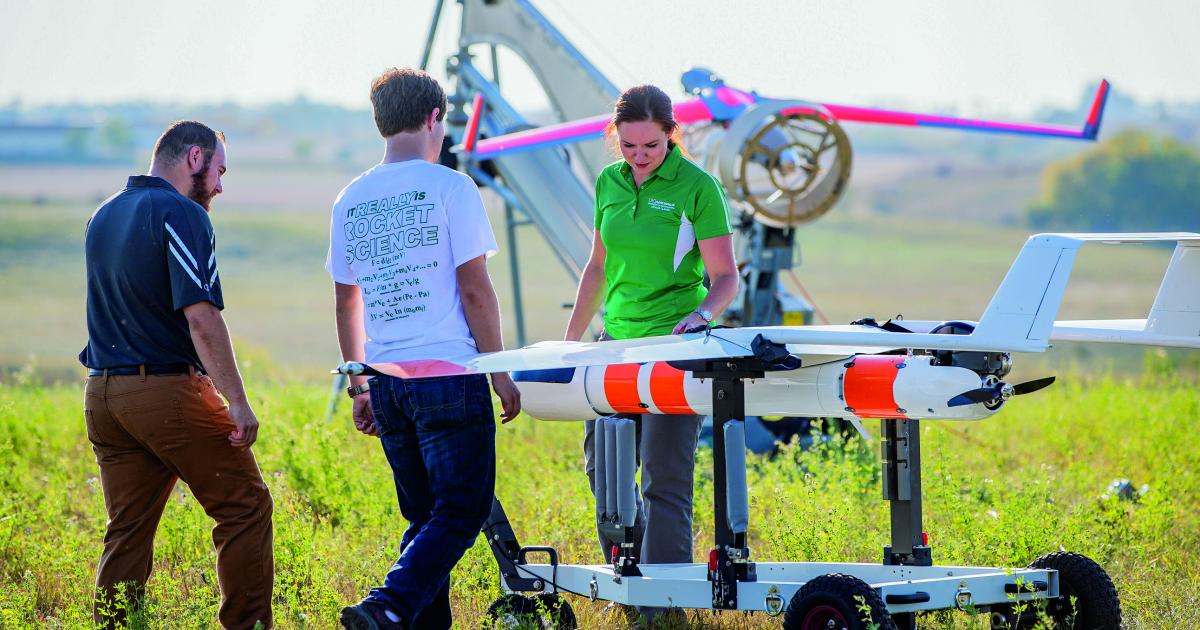When Matt Dunlevy launched SkySkopes in early 2014, it was the first company in North Dakota to send unmanned aircraft systems (UAS) skyward for commercial use.
SkySkopes, headquartered in Grand Forks and served by Nodak Electric Cooperative, offers professional flight services using UAS, or drones, in the oil fields of the Bakken region. The company uses UAS technology to assist oil companies in monitoring infrastructure and terrain. For example, fugitive gas emissions can be detected with drone-mounted optical gas imaging systems. Or detailed surveys and maps can be completed with aerial LiDAR (light detection and ranging) mapping technology.
PHOTO BY SHAWNA SCHILL/UND TODAY The University of North Dakota, along with research partners from Harris Corporation and the Northern Plains Unmanned Aircraft Systems Test Site, continues research in better utilizing UAS. A major industry milestone was reached with the first-ever test flights over a specially developed UAS network of technologies that opens the skies for broad commercial use of drones.
“The longer a UAS company has been in business, the more advanced the missions that they are able to execute,” Dunlevy said. “In drone years, a year is a blink of an eye.”
As the most mature UAS company in North Dakota, SkySkopes has found a niche in the energy sector, but drones are being launched for other uses in North Dakota, too.
Off-the-shelf drones are being used mainly for cinematography purposes, Dunlevy said. Some established businesses are using off-the-shelf UAS without outsourcing the work, such as construction or real estate companies for still photography or entry-level surveying, he said. SkySkopes encourages this type of use due to the specialty the firm has found in more complex missions, Dunlevy said.
Law enforcement might use drones for accident investigations or fugitive pursuit. Ranchers could use drones with thermal sensors to detect feverish cattle within a herd. Farmers are starting to put drones in the sky to monitor crops for pest control or plant health. Drone-mounted technology can even assist in counting plant stands within a crop.
“Some producers are flying unmanned aircraft as part of their operation,” said Mark Askelson, interim executive director of the Research Institute for Autonomous Systems at the University of North Dakota (UND) in Grand Forks. “If you need to get down to a certain resolution to do something, then the unmanned aircraft is the way to go.”
But North Dakota has even more to gain through the use of UAS, as the UND Research Institute for Autonomous Systems, in partnership with Harris Corporation and the Northern Plains UAS Test Site, is currently developing a blueprint that could be applied for flying UAS beyond the line of sight. Current Federal Aviation Administration (FAA) rules regarding drones severely restrict flying beyond the visual line of sight. So, UND is trying to prove that flying beyond the visual line of sight can be done safely, Askelson said.
That would allow inspections of pipelines or power lines to be completed more efficiently, he said.
Agriculture can also benefit from beyond-visual-line-of-sight flights, Dunlevy shared.
“There is agricultural data that can be collected from UAS, but the beyond-visual-line-of-sight capabilities make it that much more competitive,” Dunlevy said. Beyond-visual-line-of-sight capabilities will also be valuable to SkySkopes for energy missions, he added.
“We see the path forward for trying to open the airspace and we have a lot of different types of applications that we’ve gone after. That’s what we’re trying to do is blaze those trails,” Askelson said.
“If you look at the North Dakota economy, it’s soil and oil. I think it’s going to enable us to be more efficient, more effective and more competitive in the global marketplace in both soil and oil. I think it’s going to create opportunities, that it’s going to bring businesses here that need to do beyond-the-line-of-sight flight. I think it’s a huge economic driver for us,” he said.
Beyond-visual-line-of-sight flights being championed at UND “keeps the North Dakota ecosystem in the vanguard nationally of UAS development. It essentially could be a crown jewel for the state and for the researchers at the University of North Dakota. The commercial applications of their research are going to pan out to new beyond-visual-line-of-sight flight permissions that we would be able to take advantage of using similar technologies out in the oil fields,” Dunlevy said.
Advancements in UAS technology will also have a great impact on the industry, he added, including more accuracy in GPS receivers.
“That technology could be the one that sets the entire industry ablaze and has the power to give a significantly greater number of flights per day in an area, and luckily for us, it’s going to be in North Dakota,” Dunlevy said.
“It is an opportunity that will many times over pay for the investment the state’s put into it,” Askelson added.
UND’s UAS research has led the nation, and UND implemented the first four-year baccalaureate program in the country to train UAS pilots.
“UND’s role couldn’t be more significant in terms of the national presence that it has,” Dunlevy said. “There’s just nowhere else in the country that can match what UND has going on and SkySkopes derives value from that.”
“It’s something we can be proud of that we are playing those kinds of roles in making these technologies and bringing them to the benefit of the people of North Dakota and the country,” Askelson shared. “We are doing a lot of things here and we want to see that grow into successful commercialization.”
Areas of research at UND include:
• Airspace integration. “We need to get into the airspace to do what we need to do,” Askelson explained.
• Data management. As a UAS flies over a site, photographing an entire field, for instance, “you’re collecting absolutely ridiculous amounts of data,” Askelson said. UND is researching the data supply chain, discussing how to collect data, transform it into manageable information, and then apply that information to actual uses.
• Policy. Technology of any kind has drawbacks and drones are no different, but UND wants to play a role in alleviating concerns and bringing solutions, Askelson said.
“We have to make sure we have the right policies in place and the right protections in place to limit those kinds of negative impacts as much as possible and get as much beneficial impact as we can,” Askelson said.
• Create applications and work on problem sets in the energy industry, farming or other sectors.
“We’re trying to use all of these to drive the applications,” Askelson said. “Things are changing rapidly, but in a very good way.
The Association of Unmanned Vehicle Systems International shares a report that shows the economic benefit of UAS integration. Its findings shows the benefit will grow through 2025, with more than 100,000 jobs created and an economic impact of $82 billion in the United States. In North Dakota, the economic impact is at a predicted $83 million.
UAS technology is also significant from a humanitarian standpoint, Askelson pointed out.
“There are things you can do with unmanned aircraft that help save lives at times,” he said, such as medication delivery, which could be a future application, or emergency response.
“The ecosystem that we have here in North Dakota is very rich. We have a great balance of research and companies, industry. We have a government in which everybody is behind this trying to make this happen. We have a population who recognize that there can be downsides to any type of technology, but they’re also forward-looking and recognize the great benefits that technology provides,” Askelson said.
“Public awareness and public acceptance of UAS specifically in the state of North Dakota are at an all-time high,”Dunlevy said. “Drones for good are here to stay.”
Luann Dart is a freelance writer and editor who lives in the Elgin area.










